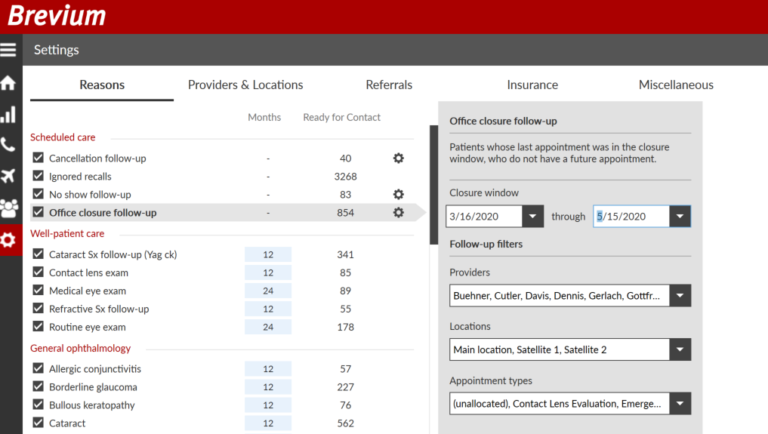The Brevium Blog

Patient Recall vs. Patient Reactivation: Unraveling the Key Differences for a Thriving Healthcare Practice
You win some, you lose some. Many providers adopt this optimistic outlook when their practices inevitably experience patient attrition; after all, patient turnover is a natural byproduct of running a business. Yet, practices sell themselves short by writing off their patients too soon. In an industry where attracting new patients is five times more expensive than reactivating a former one, patient recall and patient reactivation are needed more than ever to fuel practice growth and create viable sources of income.
Many healthcare professionals assume patient recall and patient reactivation are interchangeable—this could not be farther from the truth. These processes not only serve completely different purposes for your practice but also cater to entirely different groups of people within your established patient pool.
Patient recall refers to the process of proactively notifying due patients to return for care. Whether these are routine check-ups, preventative screenings or follow-up appointments, the goal of an effective patient recall system is to get these patients back through your door for needed treatment. Because patient turnover is inevitable, there will be times when your recall efforts fall through and your patients slip through the cracks; luckily, customer reactivation helps practices overcome this tendency.
Dubbed the “safety net,” patient reactivation is the process of identifying overdue or “lost” patients and using effective communication outreach to bring them back in for treatment. This process not only shows your inactive patients that you care about their health, but also helps you capitalize on opportunities that only established patients could offer. Knowing the difference between patient recall and patient reactivation will save your practice valuable time and energy by helping you know where to allocate your resources and how to modify your outreach with the joint goal of bringing patients back through your door.
The Patient Lifecycle: Where do patient recall and patient reactivation fit in?
The patient lifecycle refers to a patient’s treatment journey within any given practice or clinic. This journey can be broken down into four parts:
- Engagement – The process of engaging with potential patients to market your services.
- Treatment – The process of treating and providing health services.
- Follow-up – The process of monitoring patients after they’ve received treatment.
- Disengagement – This refers to patients who are not actively treating with you.
While we’ve mentioned that patient recall and patient reactivation both deal with established patients, we’ve also discussed how these strategies are aimed at different groups within the patient lifecycle. Because patient recall deals with existing patients who are due for routine care and maintenance, they would fall under the follow-up category. These are patients that are not “lost” or inactive but have waited the recommended amount of time to return for treatment.
However, many of your patients will forget to come back without being prompted to do so, costing your practice valuable time and money if these patients fail to schedule an appointment and show up; in fact, studies show that scheduling patients for recall appointments more than 90 days out significantly increases the chance that patients will not remember to come back. This fact stresses the importance of good communication between practice and patient. Implementing an effective patient recall system will not only ensure your current patients keep returning to your practice for treatment, but also helps reduce your patient churn rate while avoiding any additional costs associated with bringing them back.
However, we do not live in a perfect world where both practice and patient stay on top of appointments and treatment schedules 100 percent of the time. Luckily, patient reactivation strategies can be used to identify and contact patients who are inactive or lost—meaning these patients are overdue for care and the practice has no set plans to contact or treat them again. Depending on the diagnoses and recommended treatment intervals, these overdue patients may not have received essential care anywhere from months to years, placing them in the disengagement category. Though these patients are not actively treating with you, this does not mean you shouldn’t try to win them back; in fact, patient reactivation is not only a cheaper alternative to marketing for new customers, but also has a 20 percent higher success rate than new patient acquisition. While your successful practices are no strangers to patient turnover, you can combat this tendency with effective customer reactivation strategies that will remind your patients to return for essential care.
Your Patients Didn’t Respond to Your Recalls. Now What?
This step is where many practices get stuck. They’ve used all the tools in their arsenals just to come up short. They know their existing patients are vital to their practices and allowing them to fall inactive results in lost time and revenue. But just because your patients don’t respond to your recall attempts doesn’t mean all hope is lost; in fact, Brevium found in its 2019 ALOHA (Analysis of Lost, Overdue, High-risk, Absentee Patients) study that more than 20 percent of the lost patients studied returned for treatment after more than 30 weeks from the first contact. Sometimes, all it takes is one contact at the right time to get an inactive patient back through the door. If you give up on your patients too soon, you’ll likely lose them to another provider when or if they do decide to return. Crafting an effective patient reactivation campaign is vital for your practice’s success as it engages those patients who are actively slipping through the cracks or are already inactive and converts them back into loyal patients.
Best Practices for Patient Reactivation
Providers aren’t naïve to the fact that there are patients missing from their practices. Yet, they don’t always know the full scale of how many patients are missing and the value these established patients could bring to their growing businesses. In 2023, it’s estimated that practices spend upwards of $500 just to get one new patient through the door. With new patient acquisition costs on the rise, it’s time that medical providers start looking to their established inactive patients as a key source of revenue. Here are four tips every practice should implement to reactivate lost patients and drive practice revenue:
Use practice data to identify patients.
Perhaps the most important place to start your reactivation campaign is right in front of you: your own data. Because your practice management system tracks patient appointments, treatment histories, billing histories, prior diagnoses, and more, you have access to insights that can shed light on which inactive patients need attention first. Do you have overdue patients with critical conditions? Which patients have missed prior appointments? Which patients haven’t been treated in over a year? This step may seem like a daunting task, considering most practices have thousands of inactive patients to sift through in their databases. However, using specific patient data to narrow down your search according to the practice’s needs will make the gathering process easier. Plus, there are patient reactivation software, like Brevium, that automates this process and delivers this information to your fingertips within seconds.
Determine your reactivation goals.
Once you’ve gathered data and determined the group of patients that need to be reactivated, you can decide around which patients to craft your reactivation campaign. Are you pushing to see more patients with a specific condition? Is the goal to fill a certain provider’s schedule? Or maybe, you’re aiming for patients who have critical conditions that have been inactive for a specific amount of time? Regardless, your patient reactivation efforts should center around your practice goals and in what aspects of your practice you want to see the most growth.
Use a variety of contact methods in your outreach.
Most practices use multiple channels to contact their patients daily for a variety of reasons—it should be no different for customer reactivation. On any given day, practices might utilize phone calls, text messages, emails, social media, or direct mail to communicate with their vast patient base. While every practice might have its own opinions on the best patient outreach methods, Brevium set out to find the facts. The previously mentioned ALOHA study uncovered the most effective contact methods for reactivating lost patients with the results as follows (from most to least effective):
- Staff Calls
- Direct Mail (Postcards)
- Autocalls
- Text
Living in a technology-driven society, it’s easy to assume that emails and text messages would top this list—for daily communication, they just might. But for patient reactivation, staff calls, postcards, and autocalls were the clear winners with all having one thing in common: reachability. Out of all the contact methods analyzed, staff calls found the highest success because 95 percent of the observed inactive patients had an accessible phone number; on the flip side, only 20 percent of patients could be reached via email and 64 percent of patients via text. However successful each individual outreach method may be, the fact remains the same that you will find the most success when using a combination of outreach methods to ensure maximum reachability. Therefore, your staff only needs to spend minimal time making phone calls while the rest of your outreach can be automated.
Polite persistence pays off—don’t give up on your patients!
The more contact attempts you make, the more likely you will successfully reactivate your patients. In the 2019 ALOHA study, Brevium analyzed how outreach frequency corresponds with successful patient reactivation. The results are in: Making four to five contact attempts using multiple methods over an extended period of time can increase patient reactivation rates by 81 percent. Additionally, 20 percent of patients came back even eight months to five years after first contact. This outcome shows why practices who use patient recalls and patient reactivation simultaneously find huge success. The more persistent you are in reaching out to patients to return for treatment, whether it’s to recall or reactivate, the more likely they are to return.
Save Time and Resources with Patient Engagement Software
We’ve already discussed how effective patient recall and patient reactivation strategies will drive growth and boost revenue for your practice. What if I told you that there is software that can automate these processes for you? Even in a tech-driven industry, many practices don’t have the right tools to optimize their recall and reactivation efforts. While it’s possible to find success when you have staff reach out to patients for reminders, recalls and reactivations, these processes can be extremely time consuming when done manually. With the right patient engagement software, your staff will be spending less time on outreach efforts and more time on other high priority matters—all while boosting your revenue.
Though Brevium can be used to send reminders and recalls, the software’s specialty is patient reactivation. Brevium’s patented software takes your reactivation efforts to the next level by mining your database using diagnoses codes, procedure codes, care intervals, and other identifiers unique to the software. The software’s goal is to take what is seemingly random patient data and provide context. When and why did the patient go inactive? Why do they need to return for treatment? Which inactive patients are high-risk? Are any of these patients high-value? Gone are the days where you have to spend countless hours finding this information on your own; instead, Brevium removes this stress by integrating with your practice management system, mining the software and providing a comprehensive strategy to bring your inactive patients back.
Brevium’s software also provides you with detailed and accurate reports that provide immediate insights into the success of both your retention and reactivation efforts. By allowing Brevium to take the reins on identifying overdue patients, performing patient outreach and measuring the success of the strategies used, you are empowered to make informed decisions backed by personalized data that will ultimately enhance the patient experience and improve your ROI. See below for more information on Brevium’s process and how the software works to return your lost patients back to your practice.

With new patient acquisition costs on the rise, you must remember one thing: Your established patients are the lifeline of your practice. Not only does this group account for most of your revenue, but they are also the patients who have previously trusted you with their treatment and know how you operate. Reactivating and retaining your established patients is vital for any practice who wants to be truly successful. By making recall and reactivation top priorities for your practice, you will ultimately engage your patients to become active participants in their own healthcare while also fueling practice growth. Equipped with the right tools and knowledge, your practice has the potential to unlock new opportunities for improved patient care and access revenue sources that were previously unobtainable.
Article Sources
- Emitrr – “What is Patient Recall and why should you pay attention to it?”: https://emitrr.com/blog/what-is-patient-recall-and-why-should-you-pay-attention-to-it/#:~:text=Patient%20recalls%20are%20timed%20and,the%20practice%20reduce%20patient%20churn
- Weave – “Patient Recall: Guide To Keep Patients Coming Back”: https://www.getweave.com/patient-recall/
- Tab32 – “A Definitive Guide on lost patient recall strategy”: https://www.tab32.com/blog/the-lost-patient-recall-strategy
- SolutionReach – “The Recall Checklist You Can’t Live Without”: https://www.solutionreach.com/blog/the-recall-checklist-you-cant-live-without
- Relatient – “6 Reasons Why Your Medical Practice Needs Patient Recall Messaging Software”: https://www.relatient.com/patient-recall-messaging-software/
- GetHealthie – “Patient Lifecycle Management”: https://www.gethealthie.com/glossary/patient-lifecycle-management#:~:text=The%20patient%20lifecycle%20in%20healthcare%20generally%20consists%20of%20four%20main,out%20and%20receive%20healthcare%20services
- Cardinal Digital Marketing – “How to Reactivate Patients and Drive New Revenue Streams at your Healthcare Practice”: https://www.cardinaldigitalmarketing.com/healthcare-resources/blog/reactivate-patients-and-drive-new-revenues-at-your-healthcare-practice/
- Weave – “What All Practices Should Know About Patient Reactivation: A 5 Step Guide”: https://www.getweave.com/what-all-practices-should-know-about-patient-reactivation-a-5-step-guide/
- Practice Builders – “Patient Reactivation: Strategies, Tips and Best Practices”: https://www.practicebuilders.com/blog/patient-reactivation-strategies-tips-and-best-practices/
- RevSpring – “The Hidden Costs of Losing a Patient—And How to Keep More of Them”: https://revspringinc.com/resources/blog/the-hidden-costs-of-losing-a-patient-and-how-to-keep-more-of-them/
- Vital Interaction – “3 Key Reasons Your Patient Reactivation Process May Be Broken”: https://www.vitalinteraction.com/3-key-reasons-your-patient-reactivation-process-may-be-broken/
- RevUp Dental – “What Is The Real Cost of Acquiring New Patients?”: https://revupdental.com/what-is-the-real-cost-of-acquiring-new-patients/














